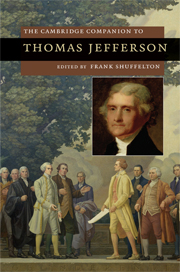Book contents
- Frontmatter
- Introduction
- 1 The Declaration of Independence and the new nation
- 2 Jefferson’s conception of republican government
- 3 Notes on the State of Virginia and the Jeffersonian West
- 4 Jefferson and Native Americans: policy and archive
- 5 Race and slavery in the era of Jefferson
- 6 Jefferson’s people: slavery at Monticello
- 7 Jefferson, science, and the Enlightenment
- 8 Thomas Jefferson and the creation of the American architectural image
- 9 The politics of pedagogy: Thomas Jefferson and the education of a democratic citizenry
- 10 Jefferson and religion: private belief, public policy
- 11 Jefferson and the language of friendship
- 12 Jefferson and Adams: friendship and the power of the letter
- 13 The resonance of minds: Thomas Jefferson and James Madison in the republic of letters
- 14 Jefferson and the democratic future
- Further reading
- Index
4 - Jefferson and Native Americans: policy and archive
Published online by Cambridge University Press: 28 May 2009
- Frontmatter
- Introduction
- 1 The Declaration of Independence and the new nation
- 2 Jefferson’s conception of republican government
- 3 Notes on the State of Virginia and the Jeffersonian West
- 4 Jefferson and Native Americans: policy and archive
- 5 Race and slavery in the era of Jefferson
- 6 Jefferson’s people: slavery at Monticello
- 7 Jefferson, science, and the Enlightenment
- 8 Thomas Jefferson and the creation of the American architectural image
- 9 The politics of pedagogy: Thomas Jefferson and the education of a democratic citizenry
- 10 Jefferson and religion: private belief, public policy
- 11 Jefferson and the language of friendship
- 12 Jefferson and Adams: friendship and the power of the letter
- 13 The resonance of minds: Thomas Jefferson and James Madison in the republic of letters
- 14 Jefferson and the democratic future
- Further reading
- Index
Summary
For many students and teachers who read Jefferson's Notes on the State of Virginia, one of the most striking or disturbing passages in the text may be the description of Jefferson's experiments as an archaeologist, in Query XI, “Aborigines.” Native American burial mounds, or “Barrows . . . are to be found all over this country” of Virginia, he wrote. Local legends offered various accounts of which, why, or how many individuals were buried beneath these mounds, and so “There being one of these in my neighbourhood, I wished to satisfy myself whether any, and which of these opinions were just. For this purpose I determined to open and examine it thoroughly. It was situated on the low grounds of the Rivanna, about two miles above its principal fork,” within the modern city of Charlottesville, but also near the site of the Monacan town of Monasickapanough. Although archaeology as a science had not yet developed by 1780, Jefferson nonetheless described in great detail the size and shape of the barrow, and the depth and arrangement of the bones he found in it. His systematic description of “part of the jaw of a child, which had not yet cut its teeth” employed anatomical terminology and reads much like a modern archaeological monograph: “The processes, by which it was articulated to the temporal bones, were entire: and the bone itself firm to where it had been broken off, which, as nearly as I could judge, was about the place of the eye-tooth.” Here as elsewhere in the Notes, Jefferson was trying to demonstrate scientific methods of inquiry and a learned vocabulary that would place him in the company of British and French anatomists such as John Hunter and Louis Jean Marie Daubenton, whom he had already cited in Query VI in writing of the elephant or mammoth bones found in the Ohio Valley.
- Type
- Chapter
- Information
- The Cambridge Companion to Thomas Jefferson , pp. 61 - 72Publisher: Cambridge University PressPrint publication year: 2009



